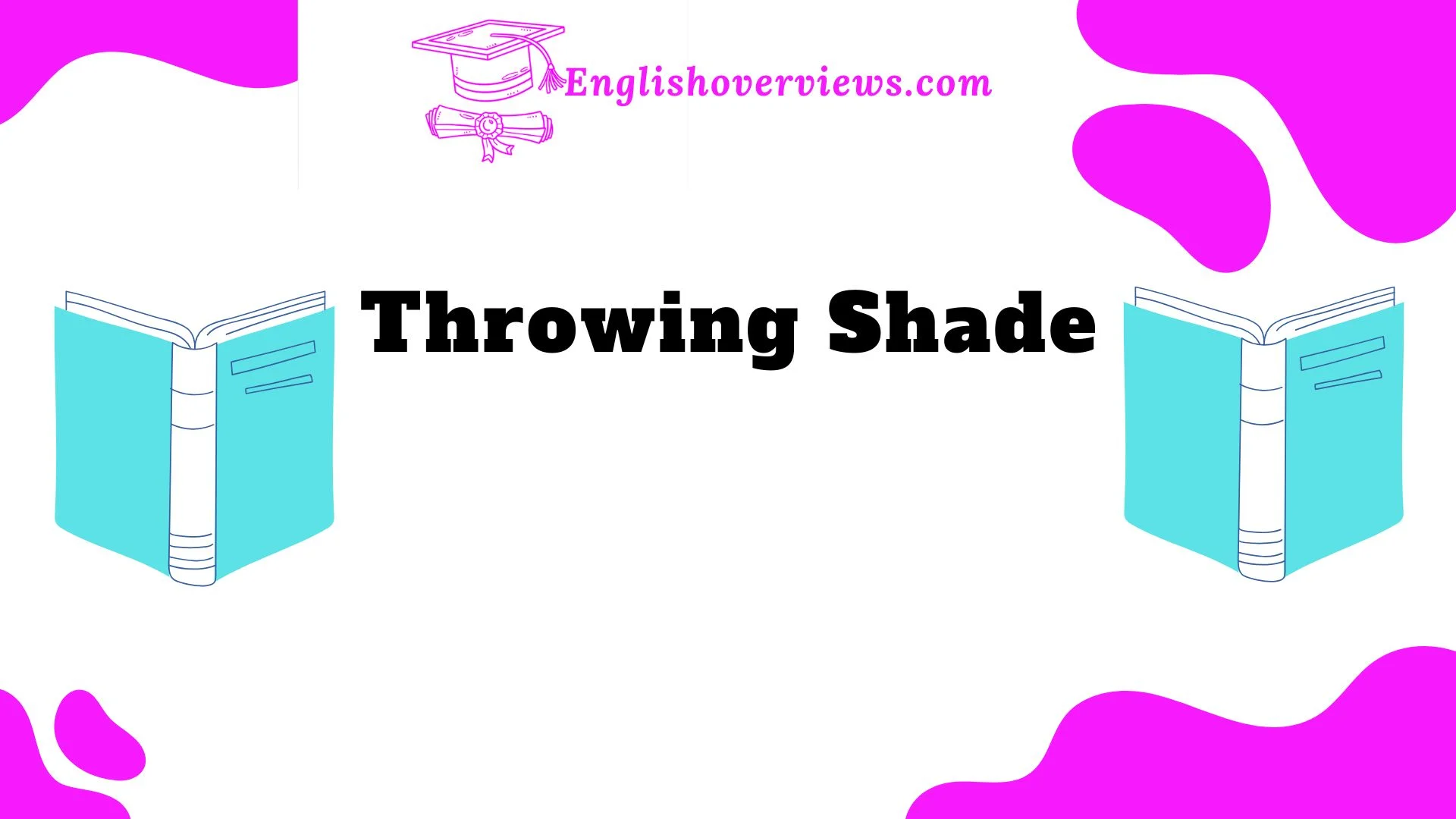Shade. It’s everywhere—online, in conversation, on TV, and even in politics. But what does it really mean to “throw shade”? You’ve probably heard the term tossed around, but the power behind it is often misunderstood. Throwing shade goes beyond a simple insult or criticism.
It’s an art form of subtlety, indirectness, and sometimes, pure sass. It can sting without ever saying a word, using a slight look, tone, or well-timed remark to make its mark.
This blog post dives deep into the world of throwing shade—its origins, its use in today’s world, and how it’s evolved across different platforms and cultures. Whether you’re a seasoned shade-thrower or just starting to understand the nuances of this powerful form of expression, this guide will explain everything you need to know.
Let’s break down the layers of meaning, usage, and examples to give you a full understanding of the art of shade.
Understanding the Meaning of “Throwing Shade”
What Does It Really Mean?
Throwing shade refers to making a subtle or indirect comment meant to insult, criticize, or belittle someone without outright saying something hurtful. It’s not a blatant insult; it’s clever, often disguised, and hard to notice unless you’re paying attention. This tactic is most often used when someone wants to insult someone without them fully realizing it.
For example:
- Direct insult: “You’re terrible at your job.”
- Shade: “Wow, it’s amazing how you still manage to get things done with so little talent.”
You can see that shade is more indirect and leaves room for plausible deniability. It’s all about playing with words and gestures to convey a message without causing an all-out confrontation.
Key Characteristics of Shade
- Subtlety: The most important characteristic of shade is its indirect nature. It’s not an out-and-out attack.
- Cleverness: It requires wit and timing. Shade isn’t just thrown without thought; it’s carefully crafted.
- Emotional Impact: The target often doesn’t realize they’ve been insulted right away, but the emotional sting sets in later.
Why is Throwing Shade So Effective?
Throwing shade allows people to maintain a level of distance while still delivering a biting critique. It’s often seen as more sophisticated than outright insults, and it allows the person throwing shade to feel in control while staying just under the radar. It’s a weapon of choice in many social interactions.
The Origins of “Throwing Shade” in the 1980s Black and Latino Gay Communities
Cultural Roots of Shade
The phrase “throwing shade” originated in Black and Latino gay communities in the 1980s. It was a part of drag culture and the ballroom scene, where people often competed in elaborate dance and fashion contests. Participants would often throw shade at each other to express their creativity and sharp wit.
In these communities, shade was not just about being mean or sarcastic—it was a way of surviving and thriving in often hostile environments. It was a tool for people to stand out in a world that didn’t always understand them. Throwing shade became a way to say “I see you, I know what you’re doing, and I can call you out without directly confronting you.”
Connection to Drag Culture
Drag queens are often credited with being some of the best at throwing shade. They mastered the art of clever comebacks and witty remarks, turning shade into a performance. In a world where drag queens were frequently marginalized, they used shade as a way to reclaim power and own the narrative.
From Subtle Insults to Mainstage Slang: Shade’s Rise in Popularity
How Shade Went Mainstream
Though the term “throwing shade” had its roots in the LGBTQ+ community, it eventually made its way into mainstream culture. With the rise of RuPaul’s Drag Race, more people became aware of shade’s power. RuPaul herself, famous for throwing shade in a playful, but cutting way, helped bring the term into the cultural lexicon.
In the 2000s, shade spread quickly through popular media, becoming a staple in conversations among celebrities, influencers, and even politicians. Celebrities would throw shade at each other during interviews, award shows, or social media posts, making it a hot commodity in pop culture.
Celebrity Influence
High-profile celebrities like Beyoncé and Nicki Minaj have made a career out of throwing shade. In fact, much of their public feuds, such as the famous Nicki Minaj vs. Cardi B rivalry, involved subtle shade-throwing that captivated audiences.
For example, during their 2018 feud, Nicki Minaj dropped a line in her song “Barbie Dreams” that subtly shaded other celebrities, including Meek Mill and Drake, without directly calling them out.
The Art of Subtlety: How to Recognize When Shade Is Being Thrown
How to Spot Shade
Recognizing when shade is thrown can be tricky, as it often involves a combination of tone, body language, and word choice. Here are some common indicators of shade:
- Sarcasm: If someone makes a seemingly complimentary statement but their tone or delivery doesn’t match the words, they may be throwing shade.
- Backhanded Compliments: For example, “You look great for someone your age.”
- Body Language: A raised eyebrow, a smirk, or an eye roll can signal that shade is being thrown.
- Context: Shade is often thrown in competitive or tense situations, so context matters. If someone is trying to upstage you or make you feel less than, chances are, shade is involved.
Examples of Shade in Action
- Example 1: “Wow, you’re so brave for wearing that outfit. Not everyone could pull that off.”
- Example 2: “I would never have thought of doing it that way. You must really have a unique approach.”
These examples show how shade is often disguised as praise, but with an undercurrent of criticism.
“Throwing Shade” in Pop Culture and Media
Movies and TV Shows
One of the most iconic moments in film where shade was thrown came from the movie Clueless (1995). The character Cher Horowitz famously throws shade by commenting on someone’s appearance, saying: “As if!” It’s a subtle way of dismissing someone’s worth, without saying anything outright insulting.
In television, shows like RuPaul’s Drag Race have turned shade-throwing into a competitive sport. Contestants frequently throw shade at each other during the judging process, leading to memorable moments that fans continue to reference.
The Role of Reality TV
Reality TV is often the playground for shade, where celebrities use the tactic to enhance their public image. Programs like The Real Housewives franchise, Keeping Up with the Kardashians, and Love & Hip Hop all feature cast members throwing shade at one another, often creating explosive drama.
The Evolution of Shade Through Memes, Celebrities, and Politics
Shade in Memes
Memes are a perfect vehicle for throwing shade in the digital age. A meme can capture the essence of shade without saying a word—think about memes that reference celebrities or politicians with sarcastic text or ironic imagery.
For example, the “How it started vs. How it’s going” meme format often throws shade by comparing a person’s past failures or awkward moments with their present achievements, highlighting their struggles in a humorous but cutting way.
Celebrities and Shade
Celebrities are no strangers to shade. One of the most famous examples comes from the 2016 MTV Video Music Awards, when Kanye West interrupted Taylor Swift’s acceptance speech, setting the stage for one of the most public shade battles in history. That moment led to years of media back-and-forth and even more shade being thrown online.
Political Shade
In politics, shade has become a common tool for leaders to subtly discredit their opponents. U.S. presidents have frequently used shade in debates or speeches, taking jabs at their rivals without outright calling them out. Barack Obama was especially skilled in this art, using clever remarks and pointed humor to throw shade while maintaining his charisma.
Effective Shade-Throwing: Tactics and Techniques
How to Master the Art of Shade
If you’re looking to throw shade effectively, here are some tips:
- Keep it subtle: The best shade is the one that isn’t immediately obvious to the untrained eye.
- Use timing: Shade is more effective when it’s well-timed, like when someone is bragging or acting overly confident.
- Use humor: Humor is a great tool in shade-throwing. It softens the blow but still delivers the message.
- Avoid direct confrontation: Keep your shade indirect and avoid being too aggressive.
The Psychology Behind Throwing Shade
When you throw shade, you tap into the psychology of the person being shaded. The goal is to undermine them without giving them the chance to respond, which often leaves them feeling disarmed or confused. It’s like playing a mental game, where you’re one step ahead.
The Rise of Shade in Digital Communication
Subtweeting and Online Feuds
On platforms like Twitter, subtweeting has become a popular method for throwing shade. A subtweet is a tweet directed at someone, but without using their name. Instead, the user hints at the person they’re shading, creating a cryptic atmosphere that draws in others.
The Anatomy of a Digital Shade
Digital shade is often amplified by emojis, hashtags, and strategically placed words. Tone can be conveyed through the use of punctuation marks like exclamation points or the eye-roll emoji, making shade even more effective in online communication.
Emoji Usage and the Nuances of Digital Shade
The Role of Emojis in Throwing Shade
Emojis have become one of the key tools in digital shade. People use emojis like the eye-roll, face with rolling eyes, and the sassy hair flip emoji to communicate their disdain without words.
How to Spot Digital Shade
Spotting digital shade can be easy once you know what to look for:
- Excessive use of sarcasm or irony.
- Selective wording that hints at criticism.
- A mix of emojis that convey frustration, annoyance, or mockery.
Conclusion: Embracing the Shade (Responsibly)
Shade has evolved from a cultural survival tool into a global phenomenon. Whether it’s on the streets, in celebrity feuds, or on your Twitter feed, throwing shade continues to captivate and entertain us. But remember, while throwing shade can be fun and empowering, it’s important to use it responsibly. Keep it playful, avoid harm, and always consider the context before throwing that shade.
FAQs
What is throwing shade? Throwing shade is a subtle, indirect way of insulting or criticizing someone, often done with clever or sarcastic remarks.
Where did the term “throwing shade” originate? The term originated in the 1980s within Black and Latino gay communities, particularly in the drag culture and ballroom scene.
How can I tell when someone is throwing shade? Look for sarcasm, backhanded compliments, or body language like eye rolls or raised eyebrows. Shade is often subtle and indirect.
Why is shade so popular? Shade is effective because it allows people to criticize or insult without direct confrontation, often leaving the recipient confused or hurt without any clear evidence of harm.
Can shade ever be harmful? Yes, while shade can be playful, it can cross the line into bullying or harassment if it’s done with ill intent.

English Overviews is a resourceful website dedicated to providing valuable content related to grammar and vocabulary. Muhammad Haroon has made notable contributions, sharing insights on various subjects, including WordPress themes and plugins. The primary goal of the site is to help users improve their English language skills effectively.











